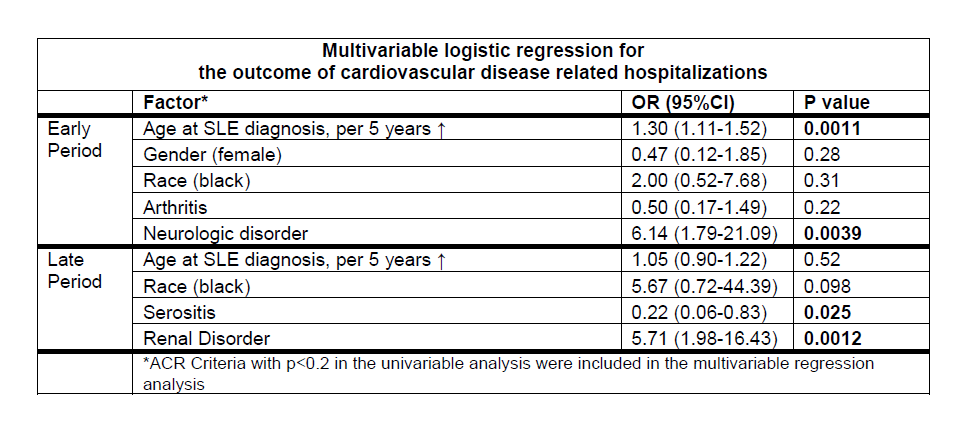Session Information
Session Type: ACR Poster Session B
Session Time: 9:00AM-11:00AM
Background/Purpose: It has long been known that mortality after years of systemic lupus erythematosus (SLE) is often associated with cardiovascular disease (CVD). Recent studies have also observed excess early CVD, even before SLE diagnosis. This is the first population-based study with large numbers of blacks to evaluate early vs. late CVD.
Methods: The Georgia Lupus Registry (GLR) is a population-based registry of SLE patients living in Atlanta, GA from 2002-04. Patients were validated by meeting ≥4 ACR criteria or 3 ACR criteria with a final diagnosis of SLE by a board certified rheumatologist and were matched to the Georgia Hospital Discharge Database, capturing all hospitalizations throughout the state from 2000 through 2013. CVD related hospitalizations (CVD-H) were identified based on the first 3 admission codes, which included ischemic heart, cerebrovascular, and peripheral vascular diseases. 2 periods were evaluated. The “Early Period” was defined as the period prior to and within the first 2 years after diagnosis. The “Late Period” was defined as the period afterwards. Multivariable logistic regression analyses were performed to explore the independent effect of demographic and disease-related factors on CVD-H.
Results: 336 incident SLE patients had 34 CVD-H’s during the surveillance period 2000-2013, 16 as Early CVD (6 ischemic heart, 7 cerebrovascular, 3 peripheral vascular) and 18 as Late CVD (4 ischemic heart, 13 cerebrovascular, 1 other vascular). Characteristics of the Early Period were a mean age at SLE and CVD-H of 52.5 and 52.2, respectively. 81.3% were female and 81.3% black. There were less photosensitivity and more serositis, renal disorder, and neurologic disorder in CVD-H compared to other incident patients (data not shown). Multivariable regression analysis showed 30% increased odds of a CVD-H for every 5-year increase in age at SLE diagnosis and over 6-fold increase in odds with neurologic disorder. Characteristics of the Late Period were a mean age at SLE and CVD-H of 40.1 and 45.8, respectively. 100% were female and 94.4% black. There was more renal disorder in CVD-H compared to other incident patients (data not shown). Multivariable regression analysis showed reduced odds (0.22) of a CVD-H with serositis and a nearly 6-fold (5.71) increase in odds with renal disorder. Race was not a factor in either period.
Conclusion: In this population-based cohort, there were significant numbers of CVD events, with nearly equal numbers of CVD-H’s in the Early Period compared to the Late Period. Consistent with previous findings, the Early Period is marked by higher risk in those with late onset of disease. The Late Period had more cerebrovascular events. Other manifestations may help identify those at higher risk for CVD-H’s.
To cite this abstract in AMA style:
Garg S, Bao G, Niyibizi M, Drenkard C, Lim SS. Differences Between Early and Late Cardiovascular Disease in a Population-Based Cohort of Systemic Lupus Erythematosus Patients [abstract]. Arthritis Rheumatol. 2016; 68 (suppl 10). https://acrabstracts.org/abstract/differences-between-early-and-late-cardiovascular-disease-in-a-population-based-cohort-of-systemic-lupus-erythematosus-patients/. Accessed .« Back to 2016 ACR/ARHP Annual Meeting
ACR Meeting Abstracts - https://acrabstracts.org/abstract/differences-between-early-and-late-cardiovascular-disease-in-a-population-based-cohort-of-systemic-lupus-erythematosus-patients/

